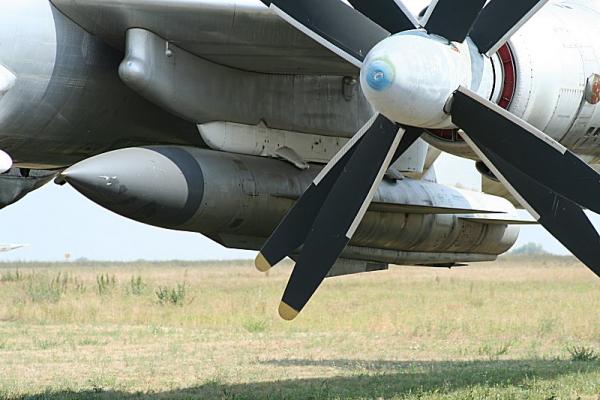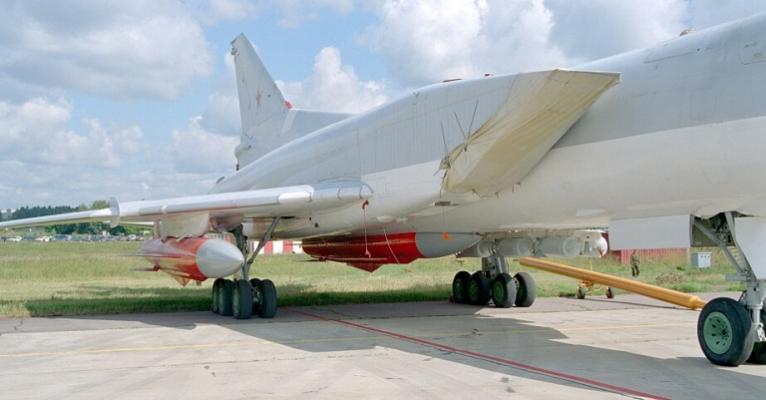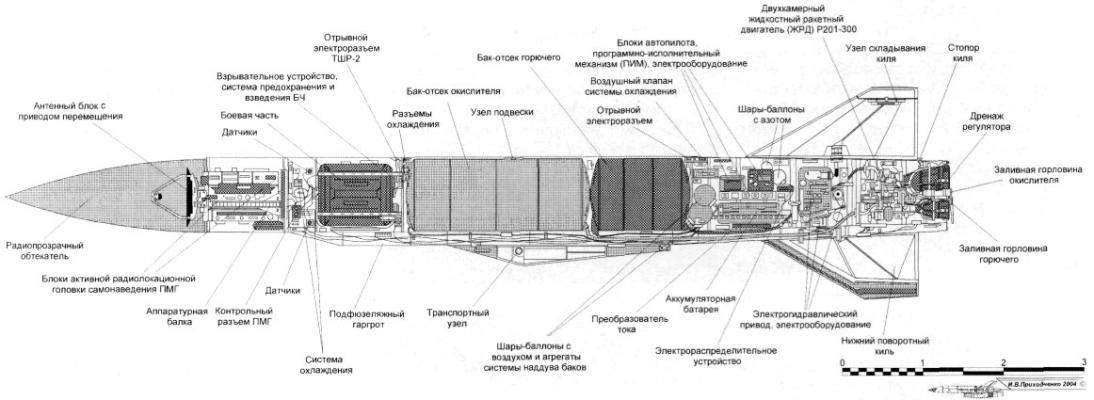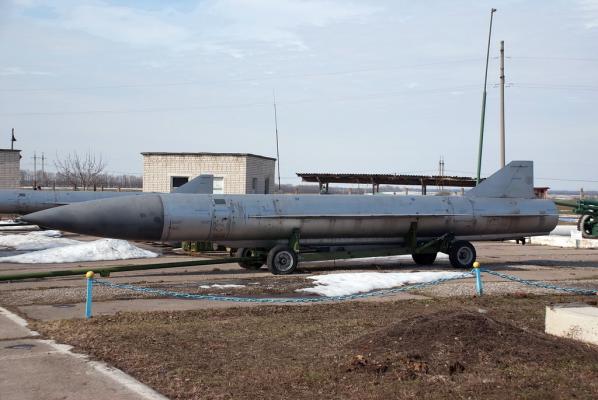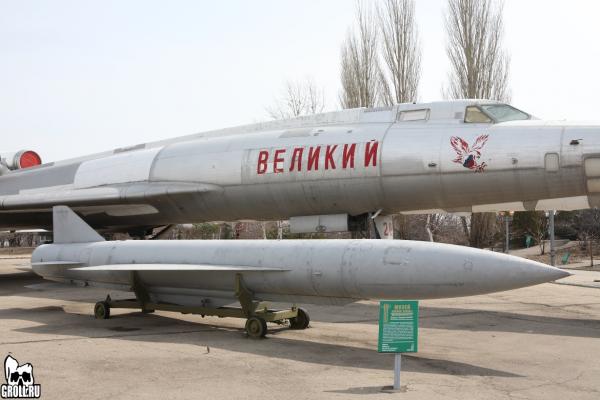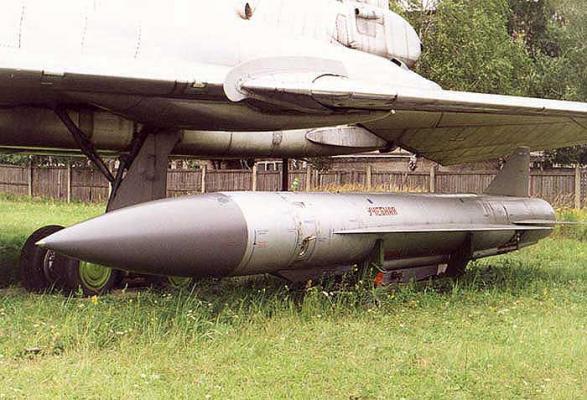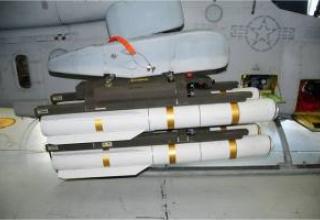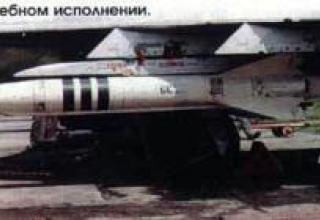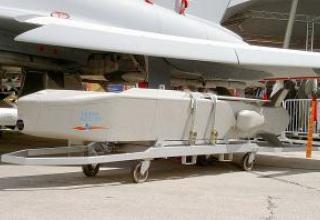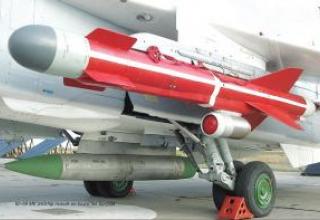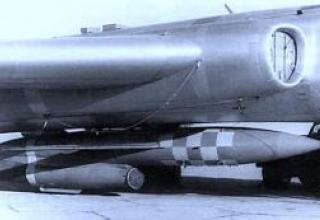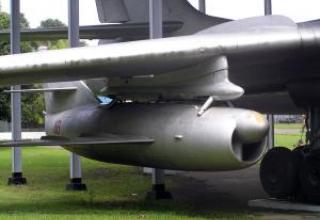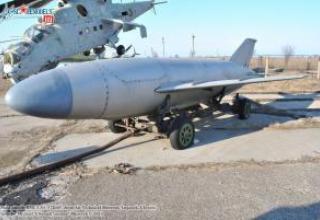Development of the K-22 aircraft and missile system based on the 105 supersonic bomber. (Tu-22, Design Bureau-156) with high-speed and high-altitude long-range missile K-22 "The Storm" were started under the Decree of the Council of Ministers of the USSR No.426-201 dated June 17, 1958. Development of the complex was entrusted to Dubna branch of Design Bureau-155 (since 1966 - Design Bureau "Rainbow", Chief Designer A.Y. Bereznyak). The missile was developed in two versions: to engage radar-contrast point targets (i.e. individual ships) and surface targets (aircraft carrier orders, convoys, ground targets). The K-22U guidance system was developed by the SCRE KB-1 in three versions - with an autonomous inertial pathfinder, as well as with active and passive radar sensors.
The new system received an index D-2. The first prototypes were manufactured in 1962 by plant No 256 of the SCAT. In 1962, began testing the missile from a specially modified Tu-16K-22. Tests have faced many difficulties. However, in 1967, the state tests of the complex K-22 as part of the carrier Tu-22K and UR X-22 with an active WGSN completed, and it was adopted by the Far Aircraft. Tu-22K received PN type radar, missile preparation equipment and a beam holder. Serial production of the X-22 began at plant 256 (since 1966 - DMZ), and then at the engineering plant in Ulyanovsk and other enterprises.
The development of the X-22PSI rocket with inertial guidance system was somewhat delayed. It was adopted for service only in 1971. In the same year a group of workers of the Rainbow Design Bureau. Berezniak was awarded the State Prize for the creation of the X-22 missile. Designing the passive anti-radar version faced unexpected difficulties. In 1962, a separate resolution of the CPSU Central Committee and the USSR CM was issued on this topic. The problem was to some extent solved only with the subsequent modifications of the X-22.
The combat capabilities of the long-range aviation with the advent of the X-22 significantly increased, the targets for the Tu-22K were, above all, the AUG of the probable enemy. But the new weapons also had disadvantages. First of all, it concerned the reliability and safety of its operation. With aggressive oxidizer and toxic fuel there were serious accidents, and the missile itself often failed after several flights on the suspension. The CWO of the PSI version was several hundred meters, which was not enough to hit point targets. Control series tests of the X-22, which were carried out jointly by the manufacturer and the Customer's representative represented by GLIC, were usually successful. For them special telemetry systems of KTA were developed, which were installed instead of BC and gave full information about operation of all systems in flight. But at firing in parts there were often failures in control system. Telemetry showed that many accidents were caused by air pollution in the control compartments and failure to maintain temperature conditions. The situation was partially corrected by the introduction of drainage.
In addition to the Tu-22K, the K-22 complex was also intended to be used for armament of the 106 family of OKB-156 and 3MD OKB-23 aircraft (as an option). But these plans were not implemented.
Designing of a new family of X-22 - D-2M modifications was started in 1967 for Tupolev missile carrier "145". First of all, the missile received a new engine. Its control system provided the flight on one of the March numbers Mach (2 and 3.4) at an altitude of 12 or 22.5 km ("lower" and "upper" trajectories respectively. For radio guided versions of the X-22M and X-22P ("active" and "passive") it was possible to capture a target from under the wing of the missile's CNS carrier. The X-22N active radar target coordinator (the same as on the old X-22) could be used to detect radio-contrast objects instead of the on-board radar of the carrier. This was achieved through the use of the advanced CNS air-conditioning system included in the design of the carrier aircraft. The guidance system of the "autonomous" X-22MA received a system of relief correction, due to which the KVO was reduced to an order of magnitude comparable to the size of a warship. In addition, it was possible to hit targets lying with a large deviation from the course of the carrier. The Course-N ("NM") system was established to provide target designation for passive CNS of X-22P. Introduction of ampoule refueling of fuel components made the X-22M operation easier and safer. Outwardly, the new missiles were distinguished by the presence of a folding sub-body keel. Another difference was the appearance of a more compact and lightweight flight locking system of all-turn plumage.
On the initiative of MMZ "Experience" and MAP in 1967 began to design the aviation missile system K-22M as part of supersonic aircraft "145" and one rocket X-22 in versions M, MA or P. The first prototype aircraft "145". (Tu-22MO) went on trial in the summer of 1969. The production plane Tu-22M2 had a central mount BD-45F and 2 underwing BD-45K, but in the normal version hung only one UR. The aircraft received the "Planeta" weapon control system with PNA radar, "Course" target designation station and NK-45 navigation complex.
X-22M and MA missiles were adopted for service in 1974, and the following year a number of employees of ICB "Rainbow" were awarded the State Prize for their creation. Serial Tu-22M2 aircraft were armed with missiles in versions of X-22M and MA. "Passive" UR X-22P was not included in the complex due to difficulties with finishing, as the missile itself, and the target designation system. Work on it was completed several years later, but it has not become truly mass. Rockets of the D-2M family were also equipped with undergoing modifications Tu-22KD aircraft. During the operation of Tu-22M2 aircraft in parts of the YES and naval aviation revealed numerous deficiencies in all elements of the complex. Their elimination continued throughout the entire period of operation of the machine. In the future, part of the Tu-22M2 was mothballed, and the rest were converted into long-range reconnaissance aircraft.
More advanced weapon was the aircraft Tu-22M3, for which were designed missiles X-22N - "active" with the new ARGSN type PMG, "passive" X-22NP - with anti-radar radar radar and "autonomous" X-22NA - with inertial guidance system. Their radar was converted to semiconductors. The new inertial control system provided high accuracy of trajectory holding, due to which the active SOS could be activated only at the final stage of the flight. This ensured a stealthy approach to the target. However, the guidance option with continuous operation of the CNS remained the main one, which ensured the specified hit accuracy.
In addition to the upper or lower trajectory options, a low altitude start was added. In this case, the missile stabilized at an altitude of about 1000 m, and on approaching the target performed a "slide". Such a launch was more stealthy, but the missile's range of flight was falling heavily.
The increase in flight and technical characteristics was ensured by the use of the new WRD. But the interference immunity of X-22N remained insufficient, as all equipment was working on a single fixed frequency, and there was no equipment to isolate the target against the interference. The resolution of the active CNS was sufficient only for detection of a target like a large ship, bridge, etc. The "passive" version of the missile again proved to be a serious problem. As a result, the operational TU-22M3s were equipped only with weapons with active CNS or inertial guidance. They were adopted for service in 1976. From the board of the Tu-22M3 could be used and missiles X-22M and MA. Despite the above mentioned shortcomings, the combat efficiency of the K-22N complex improved significantly. Now, no more than nine missiles with conventional warheads were required to defeat the aircraft carrier, which was next on the battle warrant.
In the late 70's it was decided to equip missiles X-22N modernized aircraft Tu-95KD and KM. The airplane was equipped with PNA-B radar, target designation system "Course" and three beam holders, which used units BD-45. The airplane's radars and equipment were also upgraded. The first Tu-95KD began to be improved in 1974, but the launches began only in 1981, and the Tu-95K-22 complex was adopted in service only in 1987. Tu-95K-22 could carry under the fuselage one semi-submerged missile and two - on the underwings (see photo). As the normal load Tu-22M and Tu-95K-22 could carry one, and the maximum - two missiles. Three X-22 missiles for all types of aircraft hanged only in the transport version, this is due to the difficulties of transportation of the missile. To transport one X-22 required an aircraft AN-12 or one railroad platform.
In total, according to indicative data, was built 60 aircraft Tu-22K, 370 Tu-22M, and re-equipped 45 Tu-95K-22, produced at least a thousand missiles X-22 all options. X-22 missile for a long time remained the main aircraft of medium-range defeat. Currently, the missile families D-2 and D-2M removed from service, nuclear charges from the remaining D-2N withdrawn. Tu-95K-22 aircraft are decommissioned, and part of the Tu-22M began re-equipping for X-15 anti-radar missiles. However, the X-22N remains the main weapons Tu-22M3 aircraft in the aviation of Russia and Ukraine. In the year 2000, the Tu-22M3 is still the main armament of the Russian and Ukrainian aircraft. Ukraine transferred 386 X-22 missiles to Russia on account of debt repayment and declared its intention to rearm its Tu-22Ms with high-precision new generation weapons capable of hitting point targets in the front line (this would be in line with the adopted nuclear-free status and the new military doctrine). However, such modernization, even if funds are available, will be difficult to carry out without the participation of Russian enterprises. At present, X-22 missiles remain in the arsenal of the Ukrainian Armed Forces only with conventional warheads.
In the late 1980s, Tu-22M3 and UR X-22M aircraft were offered for export. China and Iran were interested in them, but there is no information about real supplies yet.
Further development of the X-22 family was the X-32 missile. Externally, it is similar to its predecessor, but differs in its elemental base of equipment. At present, the decision to adopt the X-32 in service with the Russian aviation is being prepared. Its carriers will be airplanes Tu-22M3.
In the 70s, was created an experimental rocket K-22B (D-2B, "ballistic"). Due to the movement on a semi-ballistic trajectory, it could accelerate on a dive to a speed corresponding to the number of M = 6 and had a maximum flight height of 70 km. Technical problems closed the way to the series, but on the basis of X-22B was created a number of experimental aircraft designed to study the aerodynamics of hypersonic speeds, testing new engines (including direct current and external compression) and SAU. Some of these activities were conducted jointly with specialists from the United States.
In the west, the X-22 missile was designated (AS-4 "Kitchen").
Composition:
X-22 has a glider designed according to the normal aircraft scheme with the average wing and stabilizer (see projections).
Primarily for structural materials and components was a condition of maintaining performance at high thermal loads - the kinetic heating of surfaces at flight speeds up to 350-420 °, making unacceptable common in aircraft and rocket engineering aluminum alloys, "holding" only 130 °, except for many other materials subject to loss of strength and structure with heating (for example, many plastics in this case just burned). The main structural materials of the rocket glider steel high-strength stainless steels and titanium, with extensive use of welding for the manufacture of large units.
The X-22 fuselage consisted of 4 compartments joined together by flange joints. In the nose section of the hull there was a CNS (for the active version - radar target coordinator of PG type) or a DISS of track calculator and control system units. Behind it there was a block of air and contact fuses and BC, tanks-components of fuel, energy compartment with dry accumulators (ampoulized electrolyte was supplied to them at the moment of start-up and they worked up to the rated mode of turbine generator), autopilot APK-22A, and units of tank charge system. In the tail compartment were located the steering actuators, a single turbo-pump unit of the power plant (TNA) with a maximum flow rate of 80 kg / s and a two-chamber LCD R201-300 (C5.44) developed by OKB-300 ("Soyuz"). Fuel reserve - 3000 kg.
The triangle wing with an arrowhead of 75°, along the front edge had a supersonic symmetrical profile with a relative thickness of 2%. To ensure sufficient strength and rigidity at a low construction height (at the root it was only 9 cm), the wing was formed by a multi-spar construction with thick-walled cladding. The area of each console is 2.24 square meters. Whole rotation console symmetrical profile plumage with a relative thickness of 4.5% guided the missile on the course (the upper keel, which served as the steering wheel of the direction), roll and pitch (horizontal plumage, working in elevon mode).
To increase track stability, there was a keel under the fuselage, which housed part of the equipment antennas. The lower keel on the first specimens was removable and attached to the rocket after being suspended on an aircraft. Then, for ease of transportation, its mount was changed to an hinged one, folded to the right on the flight, thus reducing the overall height of the missile to 1.8 m. Before the flight the keel was lowered and fixed in the flight position. The power elements of the plumage, wing and fuselage were made of steel, panels of sheathing and some units were made of titanium alloys OT4-1 and BT-5 . Thermal protection covers and screens were also made of titanium, and mats made of special materials were used for internal thermal insulation of compartments and gargots. Internal frame structures for the equipment, frames and beams for fixing the equipment were manufactured by large-size casting from light magnesium alloy ML-5.
The largest units were the tanks-compartments - five-meter thin-walled structures with a supporting power set, welded from corrosion-resistant steel. The compartments also carried the wing fastening units welded to the body and then passed the joint machining - milling and cutting of joints. For strength reasons, the missile had a minimum of operational and technological hatches, cutouts of which weakened the structure - access was provided by cut-off.
Welding was widely used in the construction of the X-22. The high flight speed implied high requirements to the quality and accuracy of the glider manufacturing.
Great difficulties were encountered in mastering the production of glass fiberglass radio-transparent shrouds of GSN. These large units had very strict requirements, because they had to have stable characteristics when heated to temperatures of 350-400°C. The first series of fairings were produced at plant 301 in Khimki, but as they did not meet the technical requirements, their production was transferred to Dubna and significantly improved. Heat-resistant adhesives VS-350, PU-2, VKT-2 and VKT32-2, radio transparent material ASTT2, quartz and other mineral fibre fabrics were used in the design of the fairings.
The rocket control system included autopilot APK-22 (APK-22A), power supply was carried out with the help of "dry" ampoule battery with converter (on the suspension all rocket systems were powered from the "board" of the carrier). The battery's power capacity provided 10 minutes of power for consumers. Cylinders and units of the equipment and tanks charge system were located in the same compartment. The control system used powerful hydraulic steering drives, the energy source of which were hydro accumulators.
The R201-300 type LCD developed at the Design Bureau-300 (since April 30, 1966 - Tushino Machine Building Design Bureau "Soyuz") had a double-chamber design. Taking into account the main flight modes of the AKR, each of the combustion chambers was optimized to provide them: the starting chamber with the 8460 kgf thrust was used for acceleration and reaching the maximum speed, after which the flight was continued with the help of a marching chamber with a lower thrust of 1400 kgf, sufficient to maintain speed and altitude at economical fuel consumption. The engine was powered by a common turbo-pump unit. The dual-chamber design of the WDF provided the required range of engine throttle characteristics and simplified the design and control, eliminating complex adjustment systems. The X-22 was equipped with 3049 kg of oxidizer and 1015 kg of fuel when refueling.
The X-22 was a one-piece design and, unlike other rockets, was supplied fully assembled, without unbuttoning the consoles. The two-ton missile was delivered to the customer in a voluminous twelve-meter packing box, for transportation of which a railway platform or aircraft AN-12 was required.
To transport the X-22 at the airfield was a special airfield transport trolley AT-22, the rear wheels of which could "squat" with the help of hydraulics, allowing you to roll a bulky product under the aircraft, where the rocket was going with a minimum "gap" - the clearance under the plane was less than 2 m at the height of the X-22 itself, even with a folded lower keel of 1.81 m. For the suspension of a massive rocket, even without fuel and oxidizer, weighing 1800 kg (in the form of equipment - 5740 kg), used an electric winch, but in practice the suspension procedure had a lot of nuances, required skill and a dozen of efforts.
The X-22PSI modification with inertial guidance was designed to hit targets with given coordinates and was equipped only with a special BC of 200ct power in TNT equivalent, which could be initiated both in the air and when meeting an obstacle. X-22 was equipped with active РГСН type ПГ and was completed with a fugasno-cumulative charge "M" (weight 930-950 kg, weight ВВ - 500 kg) or SBH "Н", the same, as well as X-22PSI (this variant was the basic). When detonating, the axis of the cumulative jet is directed downwards (at an angle to the missile's axis). The X-22P could be used with a nuclear warhead or a lightweight shrapnel-phase warhead carrying 1,200 shrapnel elements.
Launchers - beam holders BD-45K, BD-45F.
- X-22M missile on the beam holder BD-45K (see projections)
- X-22MA missile on the beam holder BD-45K (see projections).
- X-22N missile on the beam holder BD-45F (see projections).
- X-22N missile on the beam holder BD-45K (see projections)
After the detachment from the aircraft (see the scheme of guidance) there is a self-ignition of fuel components and begins acceleration of the rocket with simultaneous altitude (depending on the selected program, which determines the nature of the trajectory of the rocket, set before detachment). After reaching the specified speed, the rocket engine is switched to the marching mode.
When firing at point targets, the homing head monitors the target in two planes and gives control signals to the autopilot. When accompanied by the antenna angle in the vertical plane reaches a predetermined value, a signal is issued to transfer the missile to the target dive at an angle of 30 ° to the horizon. In the area of the dive, control is performed in the vertical and horizontal planes by signals from the homing system equipment. The target detection range of the cruiser-type carrier aircraft is up to 340 km, the capture and tracking range is 250-270 km.
When firing the X-22PSI at ground targets, the carrier aircraft in flight determines the position of the target with the help of radar and other navigation aids on board the carrier. The onboard equipment of the rocket emits electromagnetic waves of a certain frequency in the direction of the target and takes them in the reflected form of "running" areas of the ground, continuously determines the vector of true speed of the rocket, which is then integrated over time, continuously determines the remaining range of the rocket to the target and is held at a rate given from the carrier. At a given distance, the autopilot translates the missile into a dive to the target at an angle of 30°. The booster is detonated at a given altitude or when it encounters an obstacle.
Characteristics:
| Carrier speed, km/h. | 950 | 1400 | 1720 |
| Launch height, km | 10 | 12 | 14 |
| Range of fire, km | 400 | 500 | 550 |
| Х-22 | Х-22P | Х-22PSI | Х-22М | Х-22МА | Х-22МP | Х-22N | Х-22NА | |
| Length, m | 11.65-11.67 | 11.67 | ||||||
| Wingspan, m | 2.99-3.0 | 3.2 | ||||||
| Fuselage diameter, m. | 0.9-0.92 | |||||||
| Rocket altitude, m | 1.81 (with keel folded) | |||||||
| Start weight, kg | 5635-5780 | 5900 | 5900-6000 | |||||
| Weight BC, kg | 630-900 | - | 930-950 | - | 930-950 | - | ||
| Guidance System | ARLGSN | PRLGSN | inertia PSI | inertia. + ARLGSN | inertia | inertia + PRLGSN | inertia. + ARLGSN | inertia. + terrain correction |
| Flight altitude, km | 22.5-25 | |||||||
| Range of fire, km | 140-300 (460-600) | 300-400 | 300-400 (560) | 300-400 | 140-300 (460-600) | |||
| Height of application, km | 10-14 (11-12) (for М-56-21) | 10 (11-12) | 10 (11-12) | up to 14 | up to 14 | up to 14 | 11-12 | 1-13 |
| Flight Speed | 3.5-4.6М | 4000km/h (4-6М) | ||||||
| Airplane carrier | 105A, Tu-22K, Tu-95K-22, Tu-106K, 3M, M-52, M-56 | 105A, Tu-22K, Tu-95K-22, Tu-106K. | Tu-22K, Tu-95K-22, Tu-135, Tu-22M. | Tu-22KD, Tu-22M | Tu-22K, Tu-22KPD, Tu-22M | Tu-22KD, Tu-22KPD | Tu-22M2, Tu-22M3, Tu-95K-22 | Tu-22M2, Tu-22M3, Tu-95K-22 |
Testing:
The X-22 missile proved to be a very effective anti-ship vehicle even without a nuclear charge. Tests have shown that in the event of a sea target being hit, the X-22 would cause damage to the target ship, which could disable an aircraft carrier or cruiser. At the take-off speed of 800 m/s, the area of the hole was up to 22 sq.m., and the inner compartments were burned by a cumulative jet to a depth of 12m.
The Soviet leadership considered the aircraft Tu-95K-22 and Tu-22M3 with the X-22 rocket the most effective tool to combat aircraft carriers. Therefore, Soviet heavy aircraft systematically approached the U.S. aircraft carriers and recorded the action of radio electronic interference Americans. According to navigators, the effectiveness of these tools was tremendous: the target markings on the screens literally drowned in a cloud of interference, it became impossible to aim. Therefore, a version of the attack was developed, according to which the first to launch X-22 missiles with nuclear warheads are not on specific targets, and the area where the American aircraft carrier connection was to be. It was believed that after that the action of electronic countermeasures will significantly reduce, and the second wave of X-22 missiles will find surviving targets.
Measures to overcome the air defense included a variety of tactical techniques: massaging efforts of several strike groups, echelonizing the combat orders of missile carriers and air defense aircraft that covered them, maneuvering during an attack. The strike could be delivered by reshaping several units and launching from different directions, frontal attack with salvo launch of dozens of missiles, consecutive disabling of cover ships, weakening of the air defense and defeating the main target. Sometimes a distraction group of aircraft stood out. During combat training, the targets were real AUGs, which were within the reach of missile-borne units. The appearance of potential enemy ship groups near the Soviet shores usually served as an excuse to work out a plan of counteraction with training anxiety and regimental flight. During daily training, crews were limited to tactical launches.
Until the beginning of the 90s, the crews of both YES and Navy conducted combat firing at sea targets in the Caspian Sea, for which the crews from remote airfields moved closer to the firing range during training sessions. Mozdok usually served as a base for "long-range" airfields, and Oktyabrskoye in Crimea served as a base for "sailors". Over time, the range in the Caspian Sea, which had been in operation since the 50s, was closed by environmentalists' demands due to the contamination of the sea with countless missile debris. Problems have also arisen with the organization of shooting at the Akhtuba range, which is now under Kazakhstan's control.
With the removal of weapons Tu-22K and Tu-95K-22 missile system K-22M continued to remain in service, using the aircraft Tu-22M3 - the most modern machines of this type. Equipped with these parts are the basis of the missile forces of the YES and the Navy in Russia and the Ukraine. By 1994, there were 92 aircraft of this type in Ukraine and the Crimea.
In April 1987, the forces of the Russian YES were consolidated into the 37th FA of the Navy. To date, the Tu-22M3 are in service with four of its air regiments, as well as two maritime missile-bearing regiments on the SF and TOF (in the early 80's at the height of Soviet aviation fleet had a fleet of one and a half dozen missile-carrying regiments).
After several years of uncertainty, rocket firing at newly equipped firing ranges also resumed (their arrangement was linked not only to the choice of small, extensive locations for safety requirements in case of missiles or irregular missile behavior, which sometimes happened, but also to the equipment of measuring posts and telemetry control points). For the first time, the Tu-22M3 of the Severomorsk Kirkenes Red Banner Air Division carried out missile launches in the Barents Sea during the Zapad-99 command and staff exercise in northern Russia. Striking together with the missile ships of the fleet, 24-26 June 1999 TU-22M3 "destroyed" detachment cover enemy ships at a range of 100 km, and the "main target" - with 300 km. In September the same year, the TU-22M3 detachment conducted missile firing at targets four X-22.
During a joint exercise of the Air Force of Russia and Ukraine August 11, 2000 a pair of Poltava Tu-22M3 made a five-hour flight to the North and together with 10 Russian aircraft attacked targets at the testing ground near Novaya Zemlya. Although only three pilots had participated in the launches before due to the long break, both target barges were hit.
Two weeks later, on 25th August 2000, the crew of the Ukrainian Tu-22M3 performed an unusual task: providing joint exercises of the Air Forces and Air Defence at the Arkhalyk range, after a long flight it fired an X-22 target missile successfully intercepted and hit by Su-27 fighters.
On 6 April 2001, during a major exercise of the 37th Air Force combined with the Yuzhny Shield-2001 KShU, the X-22 was launched, which was of research nature: a missile that had been stored in a warehouse for 25 years was taken to check reliability. Launch from the board of the Tu-22M3 at the Makat test site was a success, all systems of the X-22 worked off routinely. Less successful were the shooting at the new range near Chita in September 2002 - due to failure in the guidance missile fell in Mongolia, causing a scandal and demands for millions of compensation (the same slippage took place in Kazakhstan, where the X-22 fell near the village).
The X-22 took an exceptional place in domestic aviation and rocket technology - both in terms of the service life of the complex, approaching the 40-year mark, and the universality of application. Unlike other missiles of its class, whose service was limited to a single type of aircraft (in turn, a special modification of which was created for a certain complex of missile weapons). X-22 was armed with three carrier aircraft - Tu-22K, Tu-22M and Tu-95K-22.
However, the long service and improvement of the complex could not save it from a significant disadvantage - low serviceability associated with the use of liquid rockets. The high performance achieved by the use of liquid-propellant missiles, brought with it organic flaws and problems with ensuring the combat readiness of missiles, which required equipment with toxic and caustic components - acid and no less harmful fuel.
Prolonged storage in refueled form proved to be unacceptable due to corrosion resistance of the structure. The use of protective coatings and inhibitors - corrosion retardants - also prevented this threat from being radically eliminated. At one time, the solution was to organize a continuous cycle of work on missiles, in which at the expiration of the period of maintenance of fuel and oxidizer refueled AKR from them, removed BC, the tanks were washed with neutralizing solution, dried, and the missiles were put in storage, while the next stage of the AKR after the equipment was ready for combat duty. The labor-intensiveness of such a "carousel" with maintenance of constant combat readiness created too many obstacles; and the main direction was to improve the refueling technology, which accelerated the process as much as possible and simplified it with due security.
The most effective measure was the introduction of ampoule filling with a special unit. The oxidizer from its sealed pressure vessels was pumped into the rocket tanks, remaining virtually isolated from the environment. Filling was carried out just before firing, and storage of the missiles was no longer permitted. The equipment of the rocket technicians included a protective special suit with a woolen suit to be worn under it, thick rubber gloves on top of ordinary knitted ones, and bashila boots in a thick finger. The equipment was equipped with an insulating gas mask, and the filling process was controlled by a gas analyzer in case of leakage. Labor-intensive operations in combat units were avoided as much as possible, and flights with unpacked missiles became a common practice even at the exercises. In full, their training was carried out only when offsets launches were carried out, at best, during training sessions 1-2 times a year. Shooting was an event, and in practice, given the responsibility, only the most trained crews with similar experience were allowed to fly. The training usually took at least one month, with several rehearsals. The launch always took a couple in which a substitute crew provided backup in case of refusal. Sometimes volley launches were made by a pair of missiles or both crews, including X-22 of different types with radar and inertial guidance.
Sources:
- С.Мороз, С.Попсуевич. Управляемые ракеты дальней и морской авиации СССР
- А.В.Карпенко, С.М.Ганин, В.В.Колногоров. Авиационные ракеты большой дальности. Отечественные авиационные ракеты
- Х-22 (AS-4 "Kitchen") /Настоящие сверхзвуковые! /
- Морская ракетоносная» / Журнал «Авиация и космонавтика», N11-12, 1997г. /
- AS-4 Kitchen /FAS - Russian and Soviet Nuclear Forces /
- Ракетный комплекс К-22
